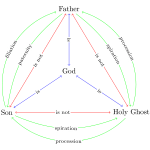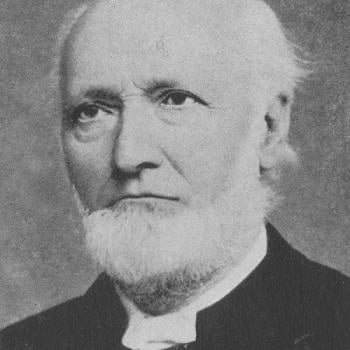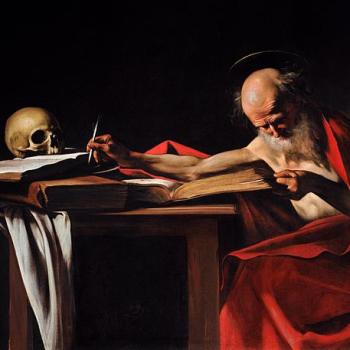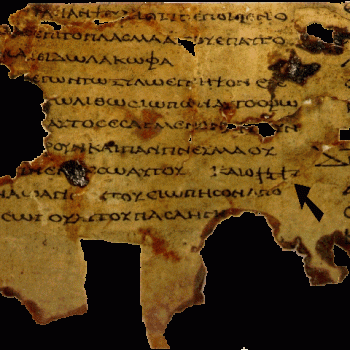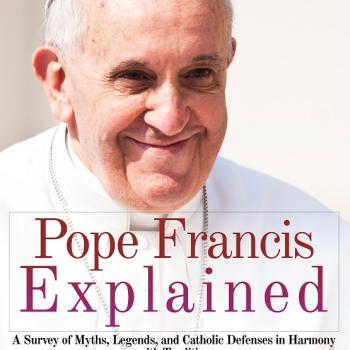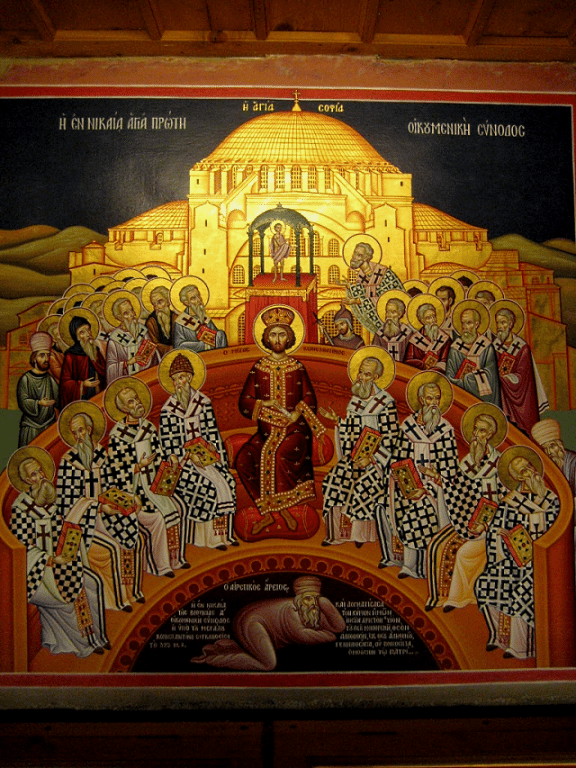
The following evidence documents papal presence (personally or through legates) at the first seven councils:
1) Nicaea, 325 [papal legates; possibly including Hosius or Ossius, who presided]
The recommendation for a general or ecumenical council . . . had probably already been made to Constantine by Ossius [aka Hosius], and most probably to Pope Silvester as well . . . Ossius presided over its deliberations; he probably, and two priests of Rome certainly, came as representatives of the Pope. (Dr. Warren Carroll, The Building of Christendom, Christendom College Press, 1987, 11)
For much more on this, see the Brian Harrison article cited below in #2 and my paper, Pope Silvester and the Council of Nicaea, and the much more in-depth article, Council of Nicea: Reply to James White: Its Relationship to Pope Sylvester, Athanasius’ Views, & the Unique Preeminence of Catholic Authority.
2) Constantinople, 381 [no pope and no legates]
No bishops from the west were present, nor was the Pope represented. Therefore, this was not really an ecumenical council, though due to later historical confusion and the enthusiastic acceptance by the whole Church of its strongly orthodox creed, including an explicit confession of the full divinity of the Holy Spirit, it came to be regarded and numbered as such. (Dr. Warren Carroll, The Building of Christendom, Christendom College Press, 1987, 62)
With the First Council of Constantinople (381) we are dealing with another case in which there are not extant acts. This council also was convoked by an emperor, Theodosius I. [Ibid.] The language of his decree suggests he regarded the Roman see as a yardstick of Christian orthodoxy. He commands all his subjects to practice the religion which Peter the apostle transmitted to the Romans. In calling the Council, Theodosius did not envisage the assembled bishops debating Roman doctrine as thought it were an open question.
The fact that Meletius of Antioch presided at Constantinople I, and the absence of any Roman legates, might appear to be evidence against the Roman primacy. It must be remembered that the Council was not originally intended to be ecumenical in the same sense as Nicaea.
It included, after all, only 150 bishops from Thrace, Asia Minor, and Egypt and was convoked to deal with certain Eastern problems.[New Catholic Encyclopedia, s.v. “Constantinople, First Council of.”] In fact, it was not recognized as ecumenical by the Council of Ephesus half a century later, and it was left to Pope Gregory the Great to elevate it to that status. (“Papal Authority at the Earliest Councils,” Brian W. Harrison, This Rock, Jan. 1991)
3) Ephesus, 431 [papal legates Arcadius, Projectus, and Philip]
The pope . . . sent two bishops, Arcadius and Projectus, to represent himself and his Roman council, and the Roman priest, Philip, as his personal representative. Philip, therefore, takes the first place, though, not being a bishop, he could not preside. It was probably a matter of course that the Patriarch of Alexandria should be president. The legates were directed not to take part in the discussions, but to give judgment on them. It seems that Chalcedon, twenty years later, set the precedent that the papal legates should always be technically presidents at an ecumenical council, and this was henceforth looked upon as a matter of course, and Greek historians assumed that it must have been the case at Nicaea. (Catholic Encyclopedia: “Council of Ephesus”; written by John Chapman)
4) Chalcedon, 451 [papal legate Paschasinus, who presided]
The honour of presiding over this venerable assembly was reserved to Paschasinus, Bishop of Lilybaeum, the first of the papal legates, according to the intention of Pope Leo I, expressed in his letter to Emperor Marcian (24 June, 451). Shortly after the council, writing to the bishops of Gaul, he mentions that his legates presided in his stead over the Eastern synod. Moreover, Paschasinus proclaimed openly in presence of the council that he was presiding over it in the name and in the place of pope Leo. The members of the council recognized this prerogative of the papal legates. When writing to the pope they professed that, through his representatives, he presided over them in the council. In the interest of order and a regular procedure the Emperor Marcian appointed a number of commissioners, men of high rank, who received the place of honour in the council.
Their jurisdiction, however, did not cover the ecclesiastical or religious questions under discussion. The commissioners simply directed the order of business during the sessions; they opened the meetings, laid before the council the matters to be discussed, demanded the votes of the bishops on the various subjects, and closed the sessions. Besides these there were present several members of the Senate, who shared the place of honour with the imperial commissioners. At the very beginning of the first session, the papal legates, Paschasinus at their head, protested against the presence of Dioscurus of Alexandria. Formal accusations of heresy and of unjust actions committed in the Robber Council of Ephesus were preferred against him by Eusebius of Dorylaeum; and at the suggestion of the imperial commissioners he was removed from his seat among the bishops and deprived of his vote. . . .
When the pope’s famous epistle was read the members of the council exclaimed that the faith contained therein was the faith of the Fathers and of the Apostles; that through Leo, Peter had spoken. . . .
At the closing of the sessions the council wrote a letter to Pope Leo I, in which the Fathers informed him of what had been done; thanked him for the exposition of Christian Faith contained in his dogmatic epistle; spoke of his legates as having presided over them in his name; and asked for the ratification of the disciplinary matters enacted, particularly canon 28. This letter was handed to the papal legates, who departed for Rome soon after the last session of the council. Similar letters were written to Pope Leo in December by Emperor Marcian and Anatolius of Constantinople. In reply Pope Leo protested most energetically against canon xxviii and declared it null and void as being against the prerogatives of Bishops of Alexandria and Antioch, and against the decrees of the Council of Nicaea.
Like protests were contained in the letters written 22 May, 452, to Emperor Marcian, Empress Pulcheria, and Anatolius of Constantinople. Otherwise the pope ratified the Acts of the Council of Chalcedon, but only inasmuch as they referred to matters of faith. This approval was contained in letters written 21 March, 453, to the bishops who took part in the council; hence the Council of Chalcedon, at least as to the first six sessions, became an ecumenical synod, and was considered as such by all Christians, both in the time of Poe Leo and after him. (Catholic Encyclopedia: “Council of Chalcedon,” written by Francis Schaefer)
5) Constantinople, 553 [no pope and no legates, due to imperial strong-arm tactics and imprisonment of Pope Vigilius]
From 25 January, 547, Pope Vigilius was forcibly detained in the royal city; . . . Vigilius had persuaded Justinian . . . to proclaim a truce on all sides until a general council could be called to decide these controversies. Both the emperor and the Greek bishops violated this promise of neutrality;. . .
For his dignified protest Vigilius thereupon suffered various personal indignities at the hands of the civil authority and nearly lost his life; he retired finally to Chalcedon, in the very church of St. Euphemia where the great council had been held, whence he informed the Christian world of the state of affairs. Soon the Oriental bishops sought reconciliation with him, induced him to return to the city, and withdrew all that had hitherto been done against the Three Chapters; the new patriarch, Eutychius, successor to Mennas, whose weakness and subserviency were the immediate cause of all this violence and confusion, presented (6 Jan., 553 his professor of faith to Vigilius and, in union with other Oriental bishops, urged the calling of a general council under the presidency of the pope. Vigilius was willing, but proposed that it should be held either in Italy or in Sicily, in order to secure the attendance of Western bishops.
To this Justinian would not agree, but proposed, instead, a kind of commission made up of delegates from each of the great patriarchates; Vigilius suggested that an equal number be chosen from the East and the West; but this was not acceptable to the emperor, who thereupon opened the council by his own authority on the date and in the manner mentioned above. Vigilius refused to participate, not only on account of the overwhelming proportion of Oriental bishops, but also from fear of violence; moreover, none of his predecessors had ever taken part personally in an Oriental council. To this decision he was faithful, though he expressed his willingness to give an independent judgment on the matters at issue. . . .
The decisions of the council were executed with a violence in keeping with its conduct, though the ardently hoped-for reconciliation of the Monophysites did not follow. Vigilius, together with other opponents of the imperial will, as registered by the subservient court-prelates, seems to have been banished (Hefele, II, 905), together with the faithful bishops and ecclesiastics of his suite, either to Upper Egypt or to an island in the Propontis. Already in the seventh session of the council Justinian caused the name of Vigilius to be stricken from the diptychs, without prejudice, however, it was said, to communion with the Apostolic See.
Soon the Roman clergy and people, now freed by Narses from the Gothic yoke, requested the emperor to permit the return of the pope, which Justinian agreed to on condition that Vigilius would recognize the late council. This Vigilius finally agreed to do, and in two documents (a letter to Eutychius of Constantinople, 8 Dec., 553, and a second “Constitutum” of 23 Feb., 554, probably addressed to the Western episcopate) condemned, at last, the Three Chapters (Mansi, IX, 424-20, 457-88; cf. Hefele, II, 905-11), independently, however, and without mention of the council. (Catholic Encyclopedia: “Second Council of Constantinople,” written by Thomas Shahan)
For more, see the Catholic Encyclopedia article, “Pope Vigilius”.
6) Constantinople, 681 [papal legates]
Owing to the desire of Pope Agatho to obtain the adhesion of his Western brethren, the papal legates did not arrive at Constantinople until late in 680. The council, attended in the beginning by 100 bishops, later by 174, was opened 7 Nov., 680, in a domed hall (trullus) of the imperial palace and was presided over by the (three) papal legates who brought to the council a long dogmatic letter of Pope Agatho and another of similar import from a Roman synod held in the spring of 680. They were read in the second session. Both letters, the pope’s in particular, insist on the faith of the Apostolic See as the living and stainless tradition of the Apostles of Christ, assured by the promises of Christ, witnessed by all the popes in their capacity of successors to the Petrine privilege of confirming the brethren, and therefore finally authoritative for the Universal Church. . . .
The greater part of the eighteen sessions was devoted to an examination of the Scriptural and patristic passages bearing on the question of one or two wills, one or two operations, in Christ. George, Patriarch of Constantinople, soon yielded to the evidence of the orthodox teaching concerning the two wills and two operations in Christ, but Macarius of Antioch, “almost the only certain representative of Monothelism since the nine propositions of Cyrus of Alexandria” (Chapman), resisted to the end, and was finally anathematized and deposed for “not consenting to the tenor of the orthodox letters sent by Agatho the most holy pope of Rome”, . . .
The letter of the council to Pope Leo, asking, after the traditional manner, for confirmation of its Acts, while including again the name of Honorius among the condemned Monothelites, lay a remarkable stress on the magisterial office of the Roman Church, as, in general, the documents of the Sixth General Council favour strongly the inerrancy of the See of Peter. “The Council”, says Dom Chapman, “accepts the letter in which the Pope defined the faith. It deposes those who refused to accept it. It asks [the pope] to confirm its decisions.
The Bishops and Emperor declare that they have seen the letter to contain the doctrine of the Fathers. Agatho speaks with the voice of Peter himself; from Rome the law had gone forth as out of Sion; Peter had kept the faith unaltered.” Pope Agatho died during the Council and was succeeded by Leo II, who confirmed (683) the decrees against Monothelism, and expressed himself even more harshly than the council towards the memory of Honorius (Hefele, Chapman), though he laid stress chiefly on the neglect of that pope to set forth the traditional teaching of the Apostolic See, whose spotless faith he treasonably tried to overthrow (or, as the Greek may be translated, permitted to be overthrown). (Catholic Encyclopedia: “Third Council of Constantinople,” written by Thomas Shahan)
7) Nicaea, 787 [papal legates archpriest Peter and abbot Peter]
The pope’s letters to the empress and to the patriarch prove superabundantly that the Holy See approved the convocation of the Council. The pope afterwards wrote to Charlemagne: “Et sic synodum istam, secundum nostram ordinationem, fecerunt” (Thus they have held the synod in accordance with our directions).
The empress-regent and her son did not assist in person at the sessions, but they were represented there by two high officials: the patrician and former consul, Petronius, and the imperial chamberlain and logothete John, with whom was associated as secretary the former patriarch, Nicephorus. The acts represent as constantly at the head of the ecclesiastical members the two Roman legates, the archpriest Peter and the abbot Peter; after them come Tarasius, Patriarch of Constantinople, and then two Oriental monks and priests, John and Thomas, representatives of the Patriarchs of Alexandria, Antioch, and Jerusalem. The operations of the council show that Tarasius, properly speaking, conducted the sessions. (Catholic Encyclopedia: “The Second Council of Nicaea,” written by Henri Leclercq)
* * * * *
Conclusion: popes were not personally present at the first seven councils. The custom in those days was to send papal legates. These were present at five of the seven councils. They weren’t at Constantinople in 381 because no western bishops at all were present; hence it was not regarded as an ecumenical council at first, because it was of an exclusively eastern nature and not representative of the universal church. But it was orthodox, and so was later declared to be ecumenical.
And they weren’t present at Constantinople in 553 because the pope was being held prisoner and the Emperor didn’t want western Catholicism to be proportionately represented. Pope Vigilius refused to participate (i.e., through legates) because of the disproportion, and due to fears of further violence. It was later deemed an ecumenical council by Rome since it was also orthodox in outcome (by God’s grace, as always).
***
(originally 4-22-09)
Photo credit: Icon from the Mégalo Metéoron Monastery in Greece, representing the First Ecumenical Council of Nicaea 325 A.D., with the condemned Arius in the bottom of the icon. Photograph by Jjensen (8-23-08) [Wikimedia Commons / Creative Commons Attribution-Share Alike 3.0 Unported license]
***



